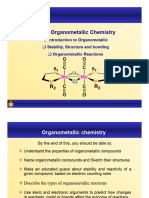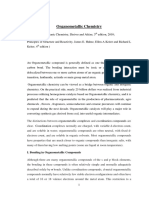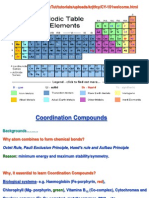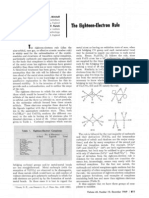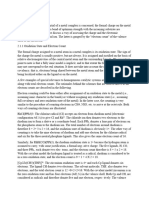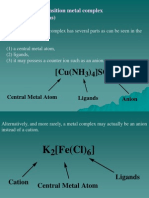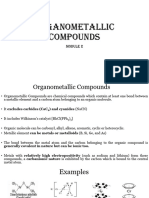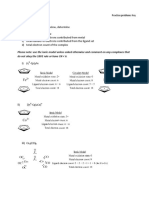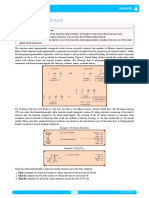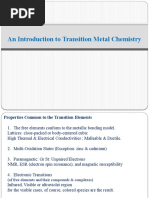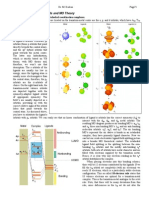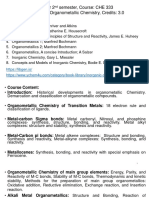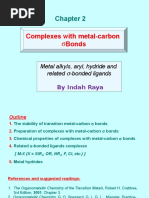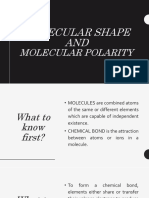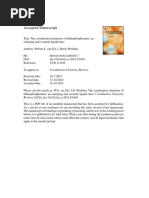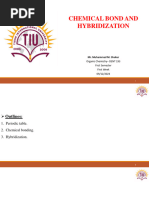Outline: General Properties of Organometallic Complexes
Outline: General Properties of Organometallic Complexes
Uploaded by
Salam NasaruddinCopyright:
Available Formats
Outline: General Properties of Organometallic Complexes
Outline: General Properties of Organometallic Complexes
Uploaded by
Salam NasaruddinOriginal Description:
Original Title
Copyright
Available Formats
Share this document
Did you find this document useful?
Is this content inappropriate?
Copyright:
Available Formats
Outline: General Properties of Organometallic Complexes
Outline: General Properties of Organometallic Complexes
Uploaded by
Salam NasaruddinCopyright:
Available Formats
Outline
1. Review on coordination chemistry
2. The 18-electron rule
3. Limitations of 18-electron rule
4. Oxidation number
5. Coordination number and geometry
6. Effect of complexation
7. Differences between metals
Chapter 1. General properties of organometallic
complexes
1. The Organometallic Chemistry of the Transition Metals, Robert H. Crabtree,
3rd Edition, 2001, Chapter 1-2.
2. Organotransition Metal Chemistry, Akio Yamamoto, 1986. Chapter 1-4.
3. Organometallic Chemistry, G. O. Spessard, G. L. G. L. Miessler, Prentice-
Hall: New Jersey, 1997, Chapter 1 3.
References
1. Review on coordination chemistry
Complexes or coordination compounds are compounds composed
of a metal and ligands which donate electrons to the metal, e.g.
H
3
N: Co :NH
3
H
3
N:
:NH
3
H
3
N Co NH
3
H
3
N
NH
3
NH
3
NH
3
..
..
3+
or
3+
NH
3
NH
3
Ligands: a molecule or ion that has at least one electron pair that can be
donated.
The electron pair can be: lone pair, t-bonding electron pair, or o-
bonding electron pair.
M
M
M
H H
M
H SiR
3
M
lone pairs, e.g.
t bonding e- pairs, e.g.
o bonding e- pairs, e.g.
H
3
N: H
3
N:
M H
2
O:
H
2
O:
M
..
..
Classification of ligands
A). Based on nature of the donating electron pairs, ligands may be
classified as Lone pair donor, t-bonding electron pair donors, o-bonding
electron pair donors.
1) Lone pair donors
M L
NH
2
-CH
2
-CH
2
-NH
2
(en)
.. ..
R-O
-
..
..
: L :
:
-
In terms of bonding:
..
L
..
L
filled empty
L
or
H
3
N:
:PR
3
:CO
M
Cl
M
M
Note:
Ligands that donate
electron pairs to form M-L o
bond are also called o
donors.
MO description of Metal-Ligand interactions
L
ligand
M
M L
ligand
M
L
ligand
Bonding
Antibonding
e.g. OR
-
R-O
..
..
:
-
M
+
(a)
R-O
..
..
M
R-O
-
:
M
+
(b)
M
R-O
M
M M
filled
M
empty
or
OR
-
OR
-
OR
-
OR
-
(a)
Note: although
ligands such as OR-
can form t bond
with a metal, we
usually don't
indicate such
interaction in writing
the structures.
Ligands that donate electrons to metal to form t bond are called t donor
How many t bonds can an OR form with a transition metal ion?
M OR
M OR
M OR
Some lone pair donor ligands may have orbitals to form
M-L t bonds. ===> t donor, t acceptor.
:C O:
C O:
C O:
C O:
C O:
+
(a)
+
(b)
empty
M
M
M
M
accept e
-
to form t bond (dt~pt back bonding)
CO is not only a o donor, but also a t acceptor.
How many t bonds can a CO form with a transition metal ion?
Ligands that accepting electrons from metal to form p bond are called t acceptor.
:C O:
C O:
C O:
C O:
C O:
+
(a)
+
empty
M
M
M
M
C O:
+
empty
M
C O:
M
C O M
C O M C O M
Can CO function as a t donor?
Types of lone pair donor ligands
strong
t acceptor
weak
t bonding
strong
t donor
lone pair
donor
CO, PF
3
NH
3
, H
-
CH
3
-
Cl
-
, OR
-
o
t
Mo
OC
OC
CO
CH
3
2.38
1.99 a)
b) IR, u (CO)
:C O
2149 cm
-1
C O H
3
B
2178 cm
-1
OC Cr
CO
CO
CO
CO
OC
2000 cm
-1
Evidences for dt-pt interactions.
* Take M-CO complexes as an example for t accepter
Explanation?
The lone pair on C atom has a little
anti-bonding character.
:C O :C O M C O M
C O
M
C O M
C O
M
C O M
-
+
1o
1t
3o
2t
4o
2o
C O
2t
3o
1t
C C
2o
C O
C
O
(anti-bonding)
*Take M-OR complexes as an example for t donor.
Mo
Mo
O
O
O
O
O
O
O
O
t-Bu
t-Bu
t-Bu
t-Bu
120
o
O
Nb
O
Tp
Tp
Tp = trypticyl
180
o
In H
2
O, O atom has sp
3
hybridization, leading to the A-O-B angle
being about 104.5. However, in the above two complexes the
angles are 120 and 180, respectively. Why ?
2). t-bonding electron pair donors
C O
M
H
2
C CH
2
M
HC CH
M
M M
How can these ligands interact with M ?
Take CH
2
=CH
2
as an example.
M
1. e- from t(C
2
H
4
) --->o (M)
M
2. e- from d t(M) --->t- (C
2
H
4
)
H
H
H H
C
C
t
C
C
t-
C
C
C
C
H
H
H H
M
Is CH
2
=CH
2
a t donor or a t acceptor?
Hapticity of ligands:
A ligand may have more than one way to bond to a metal center, e.g.
M M
or
M
CH
CH
2
CH
2
H
H
H H
H
(Cp)
H
H
H H
H
M
H
H
H H
H
M
M
In describing the number of atoms (n) attached to a metal, a short
hand q
n
is used. e.g.
M
(q
1
-C
3
H
5
)M
M
H
H
M
CH
2
CH
2
(q
2
-H
2
)M (q
2
-C
2
H
4
)M
M
Ag
+ M
(q
6
-C
6
H
6
)M (q
2
-C
6
H
6
)Ag
+ (q
4
-C
6
H
6
)M
O
CH
3
Fe(CO)
3
Ru
Fe(CO)
3
MeO
+
Exercise. Give the hapticity of ligands in following complex
Notes: Notation of bridging ligand:
n
Cl
M M
2
-Cl
Cl
M M
3
-Cl
M
C
M M
3
-CO
M
O
O
M M
2
-OR
R
M
H B
H
H
H
2
, q
3
M
M
M M
H H
H
B
H
M M
H
H
B
H
H
B
H
H
H
H
M M
2
, q
4
2
, q
2
3, q
3
3). o-bonding electron pair donors
Relatively fewer stable complexes are known.
Typical examples:
M
H
H
q
2
-H
2
OC W
OC
CO
PR
3
PR
3
H
H
q
2
-H-SiR
3
M
H
SiR
3
Mn
OC
OC
H
R
3
Si
agostic C-H
Me
2
P Ti
Me
2
P
CH
2
Cl
Cl
M
H
C
Cl
CH
2
H
or
M
H
C
How can these ligands interact with M? Take H
2
as an example.
M
H
H
H
H
M
o-bonding t-bonding
Further Notes:
* Relative basicity of electron pairs:
lone pairs > t bonding electron pairs > o bonding electron pairs
* Therefore usual order of binding ability:
lone pair donor > t bonding electron pair donor > o bonding electron pair donor.
Consequence:
M
H
H
M
CH
2
CH
2
M PR
3
CH
2
CH
2
CH
2
CH
2
H
H
:PR
3
* Some ligands have several types of electron pairs.
The types of e
-
pairs to be used to bind metal will depend on
metals. e.g.
R
C O
H
O
C
R
H
O
C
R
H
low oxidation state M
high oxidation state M
M
M
B) based on the nature of bonding interaction, ligands may be
classified as soft or hard.
Hard ligands: have low polarizability, especially those containing
period 2 donor atoms N, O, F, e.g. O
2
H, NH
3
, F
-
Soft ligands: have high polarizability, they include:
a). Those with period three or subsequent donor atoms,
e.g. Cl, Br, S, P.
b). t-acceptors, e.g. CO, CS (carbon sulfide), H
2
, CN
-
(cyanide)
c). Those containing p-electrons, e.g.
C C C C
Importance of the concepts of soft and hard ligands:
* Hard ligands tend to form stable complexes with hard metal ions,
(usually those at high oxidation state, e.g. Al
3+
, Fe
3+
, Cu
2+
, Ti
4+
, Pt(IV)).
* Soft ligands tend to form stable complexes with soft metal ions,
(usually those at low oxidation state, e.g. Mn(I), Co(I), Fe(II), Pt(II),
Pt(0) .......)
Examples:
AlF
6
3-
, Ti(OR)
4
are very stable complexes, but Pt(0)--F, Pt(0)--OR,
W(0)--F are very rare.
Cl Pt
Cl
Cl
-
stable
Pt(IV)
very rare
Exercise. explain the following facts based on the concept of Soft-Hard
Acid-Base.
1) W(CO)
6
is air stable, but W(NH
3
)
6
has never been observed.
2).
3). Low oxidation state complexes (most organometallic compounds) are
often air-sensitive, but are rarely water sensitive.
NH
2
(NH
3
)
5
Os
II
2+
- e
- NH
2
(NH
3
)
5
Os
III
3+
NH
2
(NH
3
)
5
Os
III
3+
slow
Further notes on ligands
General presentation of Ligands:
L: form coordination bond with a metal (e.g., CO, PR
3
)
X: form covalent bond with a metal (i.e., H, Cl, CH
3
)
Types of ligand coordination:
Terminal: Ligand is bound to only one metal center (L-M or X-M)
Bridging (): Ligand is attached to different metal centers
Hapticity (): Ligand attached to a metal center through more than one
atoms
MXL
5
MX2(L
2
) MXL(LX)
M
H B
H
H
H
2
, q
3
M
B
H
H
H
H
M M
2
, q
4
Further notes on ligands
Chelation: Ligand attached through more than one atom usually separated
by one or more atoms. Chelating ligands are sometimes classified as being
bidentate (2 points of attachment), tridentate (three points of attachment), or
tetradentate (4 points of attachment).
Kappa convention (): The kappa convention is sometimes used to
indicate the coordinating atoms of a polydentate ligand.
2. The 18 electron rule
1) Thermodynamically stable transition metal organometallic
compounds are formed when the sum of the metal d electrons plus
the electrons supplied by the ligands equals 18.
In this way, the metal formally attains the electronic
configuration of the next noble gas.
Ni
CO
CO
OC
OC
Fe
CO
OC
OC
CO
CO
Cr
CO OC
OC
CO
CO
CO
The 18 electron rule = 18 VE rule = inert gas rule = effective
atomic number rule (EAN rule). e.g.
Saturated complexes: 18 VE complexes
Unsaturated complexes: <18 VE complexes
10 + 4x2 = 18
8 + 5x2 = 18
6 + 6x2 = 18
Why 18?
2) Ways to count valence electrons (VE)
# VE = valence e
-
of M (or M
n+
) + e
-
from ligands
Two Models: covalent model and ionic model
Covalent model : Both M and L are considered as neutral
# VE = valence e
-
of M + e
-
from ligands + charge
e.g.
Fe
Cr
H
CO
CO
CO
OC
OC
2
2 x 5e
Fe 8e
18e
5 CO
5 x2e
H
1e
Cr
6e
1
-
1e
18e
C
5
H
5
For TM, valence e- of M = group number
Ionic model : Metal complexes are formed from M
n+
+ L + X
-
# VE = valence e- of M
n+
+ e- from ligands
Fe
Cr
H
CO
CO
CO
OC
OC
2 2 x 6e
Fe
2+
6e
18e
5 CO
5 x 2e
H
-
2e
Cr
6e
18e
C
5
H
5
-
Exercise:
Determine the valence electron count of the following complexes.
CO
OC
OC
CO
CO
Mn
Fe Fe
CO
CO
OC
O
C
OC
C
O
O
C
CO OC
Mn Mn
CO
CO
CO
CO
OC
OC
CO
CO
OC
CO
Rh
Cl
Rh
Cl
Rh
Cl
Rh
Cl
O
CH
3
Fe(CO)
3
+
O
CH
3
Fe(CO)
3
Fe(CO
3
MeO
+
Ru
Cr
Fe
OC
OC
Mn
CO
OC
OC
CO
CO
W
Rh Rh
OC
CO
(CO)
3
(PPh
3
)Fe
Ir(CO)
2
(PPh
3
)
Ph
2
P
Co Co
N
N
O
O
Do the following complexes follow the 18e rule?
ReH
7
(PPh
3
)
2
-
Cr
CO
CO
CO
H
OC
OC
Cr
CO
CO
CO
CO
OC
Rh
H
H
H
+
R
3
P Ru
H
H
H
R
3
P
PR
3
B H
H
R
3
P Ru
H
H
H
R
3
P
PR
3
B NMe
3
H
Additional exercise
Ir
N
CO
OC
Ir
OC CO
BPh
3
Ir
OC CO
PPh
3
3. Limitations of the 18 electron rule
Most OMC follow 18e rule. But there are many stable compounds that
do not have 18 valence electrons. e.g.
WMe
6
(12e) Pt(PCy
3
)
2
(14e) [Cu(NH
3
)
6
]
2+
(21e)
RhCl(PPh
3
)
3
(16e)
Some general observations:
1). Many main group complexes do not follow 18e rule:
e.g. ZnMe
2
(14e), Cp
2
Be (12e),
IF
7
(24e), SbF
6
-
(22e)
Question: When the 18e rule works?
U
U: 7s
2
5f
3
6d
1
2x8+6 = 22e
Lu Me
Lu: 6s
2
4f
14
6d
1
2x5+1+17 = 28e
2). F-block metals do not follow 18e rule. e.g.
Why? because electrons can go to (n-2)f orbitals)
3). Transition metal complexes ===> three classes
Class number of valence electrons 18e rule
I ....16, 17, 18, 19, 20 not obey
II ....16, 17, 18 not obey
III 18 obey
Class I: 3d metals with weak-field ligands
Class I n(VE) = 18 ~ 22
n(d) n(VE)
TiF
6
2-
0 12
VCl
6
2-
1 13
V(C
2
O
4
)
3
3-
2 14
Cr(NCS)
6
3-
3 15
Mn(CN)
6
3-
4 16
Fe(C
2
O
4
)
3
3-
5 17
Co(NH
3
)
6
3+
6 18
Co(H
2
O)
6
2+
7 19
Ni(en)
3
2+ 8 20
Cu(NH
3
)
6
2+
9 21
Zn(en)
3
2+
10 22
Class II: 4d and 5d metals with weak-field ligands
Class II n(VE) s 18
n(d) n(VE)
ZrF
6
2-
0 12
WCl
6
0 12
WCl
6
-
1 13
WCl
6
2-
2 14
TcF
6
2-
3 15
OsCl
6
2-
4 16
PtF
6
4 16
PtF
6
-
5 17
PtF
6
2-
6 18
PtCl
4
2-
8 16
Metals in relatively
High oxidation state
Class III: Complexes with t good acceptors
Class III n(VE) = 18
n(d) n(VE)
V(CO)
6
-
6 18
CpMn(CO)
3
7 18
Fe(CN)
6
4-
6 18
Fe(CO)
4
2-
10 18
Explanation:
L M L
L
L
L
L
Take Oh
as an example
MO levels in the absence of t acceptors.
* If A is small, eg* can be
occupied. (A < pairing energy)
===>
e
g
* (antibonding): 0 - 4e
t
2g
(nonbonding): 0 6e
a
1g
, t
1u
, e
g
(bonding): 12e
Total e-:
Minimum # of e-:
Maximum # of e-:
3d metal complexes with weak field ligands e.g. H
2
O, NH
3
and
Cl
-
belong to this class (class I).
metal
orbitals
(n-1)d
ns
np
Ligand
orbitals
(a
1g
+e
g
+t
1u
)
(a
1g
+e
g
+t
1u
)
t
1u
*
a
1g
*
e
g
*
t
2g
A
MO levels in the absence of t acceptors.
* If A is large, eg* can be occupied.
(A > pairing energy)
===>
e
g
* (antibonding): 0 e
t
2g
(nonbonding): 0 6e
a
1g
, t
1u
, e
g
(bonding): 12e
Total e-:
Minimum # of e-:
Maximum # of e-:
Complexes of 4d and 5d metals in high oxidation state belong to
this class (class II).
metal
orbitals
(n-1)d
ns
np
Ligand
orbitals
(a
1g
+e
g
+t
1u
)
(a
1g
+e
g
+t
1u
)
t
1u
*
a
1g
*
e
g
*
t
2g
A
* In the presence of t-acceptors:
A is large. t
2g
are bonding MOs, and prefer to be occupied.
===> e
g
* (strongly antibonding): 0 e
t
2g
(bonding): 6 e
a
1g
, t
1u
, e
g
(bonding): 12 e
===>Total e:
Since
organometallic
compounds
usually have t-
acceptors, A is
large and t
2g
are
bonding MOs.
They usually
have 18e valence
electrons (class
III).
metal
orbitals
(n-1)d
ns
np
Ligand
orbitals
(a
1g
+e
g
+t
1u
)
(a
1g
+e
g
+t
1u
)
t
1u
*
a
1g
*
e
g
*
t
2g
metal
orbitals
(n-1)d
ns
np
Ligand
orbitals
t
1u
*
a
1g
*
e
g
*
t*
t
2g
*
t
2g
a
1g
+e
g
+t
1u
A
A
(a
1g
+e
g
+t
1u
)
Note, just like the octet rule, the 18-electron rule is not an
absolute requirement. There are many exceptions.
Common exceptions to the 18 electron rule:
d
8
metals:
The d
8
metals (groups 8 - 11) have a
tendency to form square-planar 16
electron complexes.
This tendency is weakest for group 8
(Fe(0), Ru(0), and Os(0)) and is very
strong for groups 10 and 11 (Pd(II),
Au(III)).
d
s
p
L M L
L
L
a
1g
a
2u
e
u
x
y
z
a
1g
e
g
b
1g
b
2g
1a
1g
1a
2u
2a
1g
3a
1g
1e
u
2e
u
1b
1g
2b
1g
+1b
2g
1e
g
Because 2b
1g
orbital is very high-lying and is usually empty
d
0
metals: The high-valent d
0
complexes often have lower
electron counts than 18.
Complexes with bulky ligands: Sterically demanding
ligands will often result in lower than expected electron
counts.
> 18 electron complexes: Complexes with formally 19 or 20
electrons are known, but they are usually unstable, or
adopt alternate configurations.
The 18 Electron Rule Is Empirically Justified
The rule is
particularly useful for
Groups 6-8
16 e
-
Compounds
14 e
-
Compounds
The oxidation state of a metal in a complex is simply the charge that
the metal would have on the ionic model.
4. Oxidation number of metals and d electron count
e.g. What is the oxidation number of metals in the following complexes?
Fe
H
PR
3
PR
3
R
3
P
H
Os
PPh
3
PPh
3
Cl
Cl
OC
OC
WMe
6
H
H
d electron count: # of d electrons in the valence shell
= group # - oxidation state.
The oxidation state of a metal in a complex is simply the charge that
the metal would have on the ionic model.
4. Oxidation number of metals and d electron count
e.g. What is the oxidation number of metals in the following complexes?
Fe
H
PR
3
PR
3
R
3
P
H
Os
PPh
3
PPh
3
Cl
Cl
OC
OC
WMe
6
H
H
d electron count: # of d electrons in the valence shell
= group # - oxidation state.
W(VI) Os(II)
Fe(II)
Problems with O. S. :
a) Ambiguous oxidation states
Fe(CO)
3
Fe(CO)
3
or
Fe(CO)
3
Fe(0)
Fe(II)
Fe(IV)
or
(Ph
3
P)
2
Pt (Ph
3
P)
2
Pt
Pt(0)
Pt(II)
Os
PPh
3
PPh
3
OC
OC
CH
2
O
Os
PPh
3
PPh
3
OC
OC
CH
2
O
Os(0)
Os(II)
Convention used in this course.
Consider complexes W(CO)
6
and WH
6
(PMe
3
)
3
.
Which one would you expect to have a higher positive charge on W?
W(CO)
6
W(0): W CO backdonation
WH
6
(PMe
3
)
3
W(VI): actually more e-rich
b) charge density and formal oxidation states
There is no strict correlation between charge density and
formal oxidation states! Oxidation states in organometallic complexes
are merely formalisms that may bear little resemblance to the actual positive
charge on the metal.
Another example
Any Uses of formal oxidation states?
Oxidation number usually can not be higher than
group member !
==> predict if a compound/intermediate is possible
==> Help to formulate the structure of a compound.
e.g.
(1) Are the following species possible?
WMe
6
TiMe
6
VH
7
(PMe
3
)
2
(2) WH
6
(PMe
3
)
3
+ HBF
4
------> [WH
7
(PMe
3
)
3
] BF
4
Which of the following is unlikely the structure for [WH
7
(PMe
3
)
3
]
+
?
W
H
H
+
H
H
H
P
P
P
H
H
W
H
H
+
H
H
H
P
P
P
H
H
W
H
H
+
H
H
H
P
P
P
H
H
(a)
(b) (c)
Co
Cl
NH
3
NH
3
Cl
H
3
N
H
3
N
ReH
9
2-
six-coordinated
9-coordinated
5. Coordination number (C.N.) and geometry
a) It is easy to define C.N. for complexes with lone pair donors.
* Monodentate ligand L :
C.N. = # of L present = # of atoms bound to metal
= # of electron pairs involved in M-L o bonds.
e.g.
Polydentate ligands:
C.N. = # of atoms bound to metal
= # of electron pairs involved in M-L o bonds.
= # of L present
Co
Cl
CH
3
P
Ph
2
Ph
2
P
Ir
Ph
2
P
Cl
PPh
3
Ph
3
P
H
4-coordinated
6-coordinated
b) For Organometallic compounds, it is difficult to define C.N. e.g.
Fe Fe
OC
CO
CO
# of L
Fe
Fe
OC
CO
CO
# of M-L
Fe
Fe
OC
CO
CO
# of e pairs in M-L bond
C.N. = 1
C.N. = 5
C.N. = 3
C.N. = 1
C.N. = 4
C.N. = 2
2
+ 3
2
2
+ 3
+ 3
Convention used in this course.
We normally adopt the e- pairs in M-L bonds as # of C. N..
Fe
OC
OC
M
+
H
+
M H
+
Exercise. What is the coordination number of following complexes?
Further notes on coordination numbers:
a). For TM, C.N. 9 , why?
TM has 9 valence orbitals ((n-1)d, ns, np).
b). d
n
<==> C.N. and geometry
d
n
C.N. geometrical structure
d
6
6 prefer octahedral
d
8
4 prefer square planar
d
0
, and d
10
4 prefer tetrahedral
c). Each C.N. is associated with one or more geometries.
Some common coordination numbers and geometries
2 linear
M
Mn(CH
2
SiMe
3
)
2
3 trigonal
M
Al(mesityl)
3
T-shape
M
Rh(PPh
3
)
3
+
4
square planar
M
RhCl(CO)(PPh
3
)
2
tetrahedron
M
Ni(CO)
4
d
8
Prefered d
n
d
8
d
0
,
,
d
5
, d
10
d
0
,
,
d
5
, d
10
5
Trigonal
bipyramidal
M
Fe(CO)
5
square
pyramidal
M
Co(CNPh)
5
2+
6 Octahedron M
Mo(CO)
6
trigonal
prism
M
WMe
6
(benzonitrile)
d
8
,
,
d
6
d
6
,
,
d
7
d
6
,
,
d
3
d
0
6. Effect of complexation
M-L:
Complexation of L on M may cause:
* the change of electron density distribution on L
* new reactivity of L: unreactive ==> reactive
Examples:
a. Change the electron density on L.
donation will reduce electron-density of L.
-accepting will increase electron-density of L.
H
2
C CH
2
Fe
OC
OC
Fe
OC
OC
R
N. R. + Nu
-
but,
+ + R
-
Complexation reduce electron-density of olefin
Another example,
Mn
OC
CO
CO
Mn
OC
CO
CO
H
H
H
H
H H
H
H
H
H
H H
H
H
E
E
H
H H
H
H
+
+
E
+
- H
+
Nu
-
N. R.
E
+
N. R.
but,
NaBH
4
(H
-
)
Complexation reduces the e- density on C
6
H
6
.
Reactivity towards Nu
-
: increase
Reactivity towards E
+
: decrease
Change the electron density distribution on L
M :N N:
o-donation
:N N:
:C O:
= 0
= 0
unreactive
M C O
M N N
Upon complexation
N N:
M :C O:
C O:
t- backdonation
C O N N
M C O
M N N
overall
M C O M N N
o+ o
o+
o
Nu
- E
+
Nu
- E
+
M
M
M M
(e
-
to on both atom)
(e
-
to mainly C atom)
o
+
o
+
o
-
o
-
o
-
o
-
7. Differences between metals
1) Electronegativity differences:
Sc Ti V Cr Mn Fe Co Ni Cu
1.3 1.5 1.6 1.6 1.6 1.8 1.9 1.9 1.9
Y Zr Nb Mo Tc Ru Rh Pd Ag
1.2 1.3 1.6 2.1 1.9 2.2 2.3 2.2 1.9
La Hf Ta W Re Os Ir Pt Au
1.1 1.3 1.5 2.3 1.9 2.2 2.2 2.3 2.5
Moving from left to right, the electronegativity of the elements increases
substantially.
2). Trend in the stability of high oxidation states.
From left to right decrease
From top to bottom increase
e.g. Ti(II) unstable Fe(II) stable
Ti(IV) stable Fe(VIII) not exist
Hf(IV) very stable Os(VIII) stable
Stability of high oxidation states
Early transition metals are electropositive, so they readily lose all their
electrons to give d
0
centers (e.g. Zr(IV), Ta(V)). Low-valent early transition
metals, such as Ti(II) and Ta(III), are easily oxidized.
Late transition metals are more electronegative, thus they prefer lower
oxidation states (i.e., Rh(I) compared to Rh(III)).
2). Trend in the relative energy of d orbitals and backdonation.
Question 1: Which of the following species has d electrons of highest energy?
(1) (a) Ti(0) (b) Ti(II) (c) Ti(III)
(2) (a) Ti
2+
(b) Fe
2+
(c) Ni
2+
(d) Zn
2+
(3) Fe
Ru
Os
Question 2. How would you explain the following trend in the IR dada of
u(C-O) (in cm
-1
)?
a). V(CO)6 Fe(CO)
5
CO [Ag(CO)]
+
1976 2023 2057 2204
b) Cr(CO)
6
2000
W(CO)
6
1998
Effects of changing net ionic charge, ligands, and metal on the t basicity of a metal
carbonyl, as measured by v(CO) values (cm-1) of the highest frequency band in the IR
spectrum
Changing Metal
V(CO)
6
1976
Cr(CO)
6
2000
Mn
2
(CO)
10
2000
Fe(CO)
5
2023
Co
2
(CO)
8
2044
Ni(CO)
4
2057
Changing Net Ionic Charge in an Isoelectronic Series
[Ti(CO)
6
]
2-
1747
[V(CO)
6
]
-
1860
Cr(CO)
6
2000
[Mn(CO)
6
]
+
2090
[Fe(CO)
6
]
2+
2204
Replacing t-Acceptor CO groups by Non-t-Acceptor Amines
[Mn(CO)
6
]
+
2090
[(MeNH
2
)Mn(CO)
5
]
+
2043
[(en)Mn(CO)
4
]
+
2000
[(tren)Mn(CO)
3
]
+
1960
M
H
H
H
H
M
2. e- from d t(M) ---> o- (H
2
)
1. e- from o(H
2
) --->o (M)
H
H
M
o(H
2
)
o*(H
2
)
Bonding picture of M(H
2
)
Question 3. Compounds of the formula MH
4
P
3
(M = Fe, Ru and Os, P = PR
3
)
are known to have the following structure.
P Fe H
P
P
H
H H
P Ru H
P
P
H
H H
P Os
H
P
P
H
H
H
why not
P Os H
P
P
H
H H
?
You might also like
- AAMC MCAT Test 8 PDFDocument79 pagesAAMC MCAT Test 8 PDFAwan Ramadhan100% (1)
- Problem Set 6 KeyDocument4 pagesProblem Set 6 KeyryezhuNo ratings yet
- Detailed MEXT Undergrad SyllabusDocument11 pagesDetailed MEXT Undergrad SyllabusYuki Ko100% (5)
- Chemistry: a QuickStudy Laminated Reference GuideFrom EverandChemistry: a QuickStudy Laminated Reference GuideRating: 4.5 out of 5 stars4.5/5 (2)
- 11 Chemistry Solved Questions Chapter 4Document4 pages11 Chemistry Solved Questions Chapter 4nathansolaiNo ratings yet
- Chapter 1Document67 pagesChapter 1Fitriani SariNo ratings yet
- Outline: General Properties of Organometallic ComplexesDocument70 pagesOutline: General Properties of Organometallic ComplexesikalailatulNo ratings yet
- SCHM 312 - Unit 4-Notes - 2020Document14 pagesSCHM 312 - Unit 4-Notes - 2020imfene955No ratings yet
- Cont'd Mode of Bonding: Binding ModesDocument34 pagesCont'd Mode of Bonding: Binding ModesDingetegna GodanaNo ratings yet
- Elias Inorg Lec 5Document14 pagesElias Inorg Lec 5Sreedevi KrishnakumarNo ratings yet
- CY 101coordination Compounds1Document121 pagesCY 101coordination Compounds1Mukul SuryawanshiNo ratings yet
- CH6 InCh3101Document64 pagesCH6 InCh3101Fasil ManNo ratings yet
- General Features - Chapter 1Document18 pagesGeneral Features - Chapter 1golokchandmandalNo ratings yet
- Inorganic Notes - OrganomettalicsDocument26 pagesInorganic Notes - OrganomettalicsrohitNo ratings yet
- Organometallic Chemistry: CH 431 MFT CH 13Document37 pagesOrganometallic Chemistry: CH 431 MFT CH 13Vaittianathan MahavapillaiNo ratings yet
- Wk11omc 1COcomplexesDocument13 pagesWk11omc 1COcomplexesAndre PNo ratings yet
- Coordination CompoundsDocument97 pagesCoordination CompoundsAnant SharmaNo ratings yet
- Introduction To Organometallic Chem 01-4Document21 pagesIntroduction To Organometallic Chem 01-4Aparna DuggiralaNo ratings yet
- L3 SlidesDocument14 pagesL3 SlidesAakash LawaNo ratings yet
- CHM 4301 Advanced Inorganic: Bonding in Organometallic CompoundDocument30 pagesCHM 4301 Advanced Inorganic: Bonding in Organometallic CompoundAnonymous lClX1bNo ratings yet
- Screenshot 2024-03-17 at 11.53.31 PMDocument65 pagesScreenshot 2024-03-17 at 11.53.31 PMjejeprm0No ratings yet
- OrganometallicsDocument58 pagesOrganometallicsRohit ChaudharyNo ratings yet
- IC - Lecture 6ADocument25 pagesIC - Lecture 6ADusuNo ratings yet
- Carbonyls PDFDocument10 pagesCarbonyls PDFMaheshNo ratings yet
- Organometallic CompoundsDocument66 pagesOrganometallic CompoundsJon Ho100% (1)
- The Eighteen-Electron RuleDocument4 pagesThe Eighteen-Electron RuleCarlos AlarconNo ratings yet
- DHHDocument3 pagesDHHChiến PhùngNo ratings yet
- Orm 33Document114 pagesOrm 33Md Akash AliNo ratings yet
- Electron Counting 2000 2Document11 pagesElectron Counting 2000 2حسين علي كاظم كحويشNo ratings yet
- Chapter 21 Crystal FieldDocument42 pagesChapter 21 Crystal FieldPhilosopher's GuildNo ratings yet
- Coordination Compounds Part 2Document56 pagesCoordination Compounds Part 2Preetika GuptaNo ratings yet
- Inorganic ChemistryDocument20 pagesInorganic ChemistrySatyajit LenkaNo ratings yet
- Electron Counting in Organometallic Chemistry: 1. The 18-Electron Rule Definition & RationalisationDocument11 pagesElectron Counting in Organometallic Chemistry: 1. The 18-Electron Rule Definition & Rationalisationgaurav100% (1)
- Lecture 24 Transition Metal Complexes-2019Document72 pagesLecture 24 Transition Metal Complexes-2019asgjcgirlskkdNo ratings yet
- Chap03 CarbonylsDocument10 pagesChap03 CarbonylsAPLCTNNo ratings yet
- Chemistry of Transition MetalsDocument44 pagesChemistry of Transition MetalsAqilah MahabirNo ratings yet
- Coordination CompoundDocument8 pagesCoordination Compounduser-247466No ratings yet
- The 18 Electron RuleDocument5 pagesThe 18 Electron RuleJavier MedinaNo ratings yet
- ComplexesDocument20 pagesComplexespunt3yNo ratings yet
- 5_Coordination CompoundsDocument3 pages5_Coordination Compounds35razer3500No ratings yet
- Engineering ChemistryDocument60 pagesEngineering ChemistryAditya ShindeNo ratings yet
- An Introduction To Transition Metal ChemistryDocument41 pagesAn Introduction To Transition Metal ChemistryPari GandepalliNo ratings yet
- Coordination ChemistryDocument30 pagesCoordination ChemistryKarin31No ratings yet
- Inorganic Chapter19Document23 pagesInorganic Chapter19barkatullah0% (1)
- Case in Point: Tetrahedral Vs Octahedral ComplexesDocument33 pagesCase in Point: Tetrahedral Vs Octahedral ComplexesShubham KumarNo ratings yet
- Lewis Structures and Shape of Molecules and HybridizationDocument12 pagesLewis Structures and Shape of Molecules and HybridizationsanjuanaomiNo ratings yet
- MOT Inorganic ChemistryDocument3 pagesMOT Inorganic ChemistryLohith Loli100% (1)
- CHE 33-Lecture-1Document30 pagesCHE 33-Lecture-1Arafat Ahmed SajibNo ratings yet
- Catalysis 2Document70 pagesCatalysis 2Demon SamNo ratings yet
- Coordination CompoundsDocument18 pagesCoordination CompoundsPankaj JindamNo ratings yet
- Organic Chem. NotesDocument117 pagesOrganic Chem. NoteselcarlsansNo ratings yet
- 1 C IUua Jel Mup ZZX72 R 1 JDocument18 pages1 C IUua Jel Mup ZZX72 R 1 JsavaruchaursiyaNo ratings yet
- MetalsDocument39 pagesMetalsAditya ChudasamaNo ratings yet
- Chem261 Part 1-A and BDocument33 pagesChem261 Part 1-A and BAriana NaidooNo ratings yet
- Nomenclature and 18 Electron RuleDocument25 pagesNomenclature and 18 Electron RuleJim Livingston100% (1)
- Chapter 2 (After Lecture For Students)Document119 pagesChapter 2 (After Lecture For Students)Fitriani Sari100% (1)
- LECTURE 6 Metal CarbonylDocument57 pagesLECTURE 6 Metal Carbonylelikaliko1No ratings yet
- 1CHEM261 Part1A WVZDocument30 pages1CHEM261 Part1A WVZndlovumpendulo281No ratings yet
- Chapter - 5 Coordination CompoundsDocument11 pagesChapter - 5 Coordination CompoundsSuresh Dasaraddi67% (3)
- Lecture 20. An Introduction To Organometallic Chemistry: Benzene The Sandwich' Complex of CR (0), Which Is (CR (Benzene) )Document16 pagesLecture 20. An Introduction To Organometallic Chemistry: Benzene The Sandwich' Complex of CR (0), Which Is (CR (Benzene) )Hafizah RamliNo ratings yet
- Kuliah Kimia Organik Lanjut s1Document690 pagesKuliah Kimia Organik Lanjut s1rury haza yandiNo ratings yet
- Molecular Shape and Molecular PolarityDocument15 pagesMolecular Shape and Molecular PolaritySonny Boy SajoniaNo ratings yet
- Semiconductor Device Technology by Malcolm E. Goodge PDFDocument505 pagesSemiconductor Device Technology by Malcolm E. Goodge PDFelpatotas22No ratings yet
- Chapter 25 Vocabulary - Organic ChemistryDocument2 pagesChapter 25 Vocabulary - Organic ChemistryEvilasio CostaNo ratings yet
- Chapter 7 Chemical EnergeticsDocument2 pagesChapter 7 Chemical Energeticssitinur qahirahNo ratings yet
- NUR11O1 Integrated Human Anatomy and Physiology Department of Biology Institute of Arts and Sciences Far Eastern UniversityDocument5 pagesNUR11O1 Integrated Human Anatomy and Physiology Department of Biology Institute of Arts and Sciences Far Eastern UniversityGeia Marie SilveroNo ratings yet
- The Center of Gravity of An Isosceles Triangle Whose Height Is H On The Median LineDocument232 pagesThe Center of Gravity of An Isosceles Triangle Whose Height Is H On The Median Linekristan7No ratings yet
- Chemical Bond Class-11 NOTESDocument35 pagesChemical Bond Class-11 NOTESsibaranjandash2007No ratings yet
- Accepted Manuscript: Coordination Chemistry ReviewsDocument48 pagesAccepted Manuscript: Coordination Chemistry ReviewsLuis Fancisco Alcaraz BlancasNo ratings yet
- 2nd. Revised Completed Einstein General Theory of RelativityDocument23 pages2nd. Revised Completed Einstein General Theory of RelativitynadgobNo ratings yet
- AP-Chem_챕터별-기출문제모음Ch02Document4 pagesAP-Chem_챕터별-기출문제모음Ch02hwankim809No ratings yet
- Part 1 Physical ScienceDocument26 pagesPart 1 Physical ScienceRonald A. CarniceNo ratings yet
- ThesisDocument175 pagesThesisSanam Sri RanjanNo ratings yet
- Chem 3 Chemical BondingDocument110 pagesChem 3 Chemical BondingC1A 05 Ashwina JNo ratings yet
- Chem Mid Term and Answer KeyDocument10 pagesChem Mid Term and Answer KeyNatasha Kishore PandaranNo ratings yet
- English For ChemistsDocument72 pagesEnglish For ChemistsJanka SzöőrNo ratings yet
- November 2021 QP - Paper 2 OCR (A) Chemistry As-LevelDocument16 pagesNovember 2021 QP - Paper 2 OCR (A) Chemistry As-Levelusmanhasib2504No ratings yet
- RituDocument33 pagesRitukamara70100% (1)
- 3.5.4 Test (TST) - Teacher-Scored Unit Test (Test)Document10 pages3.5.4 Test (TST) - Teacher-Scored Unit Test (Test)mtassone2009No ratings yet
- Pre Ph.D. Exam 2019-20: 9009-Ruhs PHD Exam (Pharmaceutical Chemistry) Question Paper With Answer Key Common SectionDocument20 pagesPre Ph.D. Exam 2019-20: 9009-Ruhs PHD Exam (Pharmaceutical Chemistry) Question Paper With Answer Key Common SectionFarhadz Sailama Barahama100% (1)
- Chemical Bond and Hybridization1Document27 pagesChemical Bond and Hybridization1diyarberwari15No ratings yet
- Manual ChemBioOffice y Chem3DDocument579 pagesManual ChemBioOffice y Chem3DByronNo ratings yet
- 9 Chemistry Series Test # 4: Q. 1: Choose The Correct Option.Document3 pages9 Chemistry Series Test # 4: Q. 1: Choose The Correct Option.CosmeriesNo ratings yet
- Chemistry NotesDocument24 pagesChemistry Notesluayolivia1No ratings yet
- Water BiochemistryDocument11 pagesWater Biochemistry1082mariano.g.jrNo ratings yet
- Physical Chemistry CambridgeDocument11 pagesPhysical Chemistry CambridgeNehaNo ratings yet
- Edcp - 1Document19 pagesEdcp - 1Raja AdnanNo ratings yet
- The P-Block ElementsDocument20 pagesThe P-Block ElementsNabiha KaleemNo ratings yet











